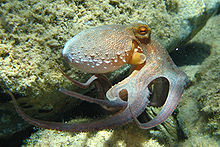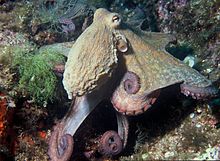- Common Octopus
-
Common Octopus 
Scientific classification Kingdom: Animalia Phylum: Mollusca Class: Cephalopoda Order: Octopoda Family: Octopodidae Genus: Octopus Subgenus: Octopus Species: O. vulgaris Binomial name Octopus vulgaris
Cuvier, 1797Synonyms - Octopus vulgaris
Lamarck, 1798 - Octopus rugosus
Bosc, 1792
The Common Octopus (Octopus vulgaris) is the most studied of all octopus species. Its natural range extends from the Mediterranean Sea and the southern coast of England to at least Senegal in Africa. It also occurs off the Azores, Canary Islands, and Cape Verde Islands.[1]
Contents
Characteristics
O. vulgaris grows to 25 cm in mantle length with arms up to 1 m long.[1] O. vulgaris is caught by bottom trawls on a huge scale off the northwestern coast of Africa. More than 20,000 tonnes are harvested annually.[1]
The Common Octopus hunts at dusk. Crabs, crayfish, and bivalve mollusks (two-shelled molluscs such as cockles) are preferred, although the octopus will eat almost anything it can catch. It is able to change colour to blend in with its surroundings, and is able to jump upon any unwary prey that strays across its path. The prey is paralyzed by a nerve poison, which the octopus secretes, and the octopus is able to grasp its prey using its powerful tentacles with their two rows of suckers. If the victim is a shelled mollusc, the octopus uses its beak to punch a hole in the shell before sucking out the fleshy contents.[citation needed]
Training experiments have shown that the Common Octopus can distinguish the brightness, size, shape, and horizontal or vertical orientation of objects. They are intelligent enough to learn how to unscrew a jar and are known to raid lobster traps.[2][3] O. vulgaris is the only invertebrate animal protected by the Animals (Scientific Procedures) Act 1986 in the UK; it was included because of its high intelligence.[citation needed]
See also
References
- ^ a b c Norman, M.D. 2000. Cephalopods: A World Guide. ConchBooks.
- ^ http://www.youtube.com/watch?v=BO1PnQ-1-pY
- ^ http://www.youtube.com/watch?v=LEvXcocqmYE
External links
- Javier Quinteiro, Tarik Baibai, Laila Oukhattar, Abdelaziz Soukri, Pablo Seixas, & Manuel Rey-Méndez, Multiple paternity in the common octopus Octopus vulgaris (Cuvier, 1797), as revealed by microsatellite DNA analysis; Molluscan Research 31(1): 15–20 ; ISSN 1323-5818
- CephBase: Common Octopus
Edible mollusks Bivalves Atlantic jackknife • Atlantic surf • Geoduck • Grooved carpet shell • Hard clam • Horse • Mactra stultorum • Blunt gaper • Ocean quahog • Pacific razor • Pecten jacobaeus • Venus • California butterclam • Senilia senilis • Smooth clam • Soft-shell • Triangle shell • Tuatua • Japanese littleneck • Razor clam • Pod razor • Ensis (razor genus) • PaphiesBlue • Mediterranean • New Zealand green-lipped • California • Brown • Asian/Philippine green • Date • Mytilidae (mussel family)Auckland • Eastern • Olympia • Southern mud • Colchester native • Pacific • Portuguese • Windowpane • Rock • Sydney rock • Ostra chilena/Bluff • Gillardeau oysters • Crassostrea ("true oyster" genus)Gastropods Queen • DogBlack foot opihi/Haiwaiian • China • Common European • Rayed Mediterranean • Ribbed Mediterranean • Rustic • Turtle/Talc • Yellow foot opihiLandFreshwaterNeritesInkfish Spineless • BottletailChitons Chiton magnificus • Acanthopleura granulataRelated topics: Oyster farming • Land snail farming • Categories:- Octopuses
- Fauna of Gough Island
- Animals described in 1797
- Octopus vulgaris
Wikimedia Foundation. 2010.


